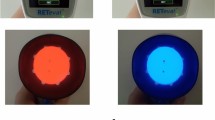Abstract
The electro-oculogram (EOG) can be recorded by use of skin electrodes positioned near the eye in the horizontal or vertical plane and is dependent on the position of the eye relative to the electrodes and the size of the corneo-retinal potential (CRP). By use of the functional relation between the recorded potential and the eye position - CRP is considered to be constant - the EOG is the eye movement recording method most often used. Changes in CRP dependent on luminance or metabolic influences can be measured, on the other hand, by means of the EOG when eye movements of constant amplitudes are performed. The EOG in this paper is used in the latter sense.
The widely used clinical test of rentinal function based on the electro-oculogram firstly described by Arden (Arden index) has been modified to achieve more precise and reliable results by including a gradual dark adaptation procedure and a special data analysis to detect fixation periods. Using modern techniques, the complete procedure has been automated. The efficiency of the procedure and the device is demonstrated in various ways.
Similar content being viewed by others
References
Anderson ML, Purple RL. Circadian rhythms and variability of the clinical electro-oculogram. Invest Ophthalmol Vis Sc 1980; 19,3: 278-288
Arden GB, Barrada A, Kelsey JH. New clinical test of retinal function based upon the standing potential of the eye. Br J Ophthalmol 1962; 46: 449-467
Behrens F, Weiss LR. An algorithm separating saccadic from nonsaccadic eye movements automatically by use of the acceleration signal. Vision Res 1992; 32,5: 889-893
Dawson WM, Maida TM. Reduced variability in the electro-oculogram. Am J Ophthalmol 1984; 97(3): 395-396
van Lith GHM, Balik J. Variability of the electro-oculogram (EOG). Acta Ophthalmol 1970; 48: 1091-1096
Marmor MF, Zrenner E. Standard for clinical electro-oculography. Arch Ophthalmol 1993; 111: 601-604
Miles WR. The steady polarity potential of the human eye. Proc nat Acad Sci (Wash.) 1939; 25: 25-36
Petsch J. DEAndy Datenerfassungseinheit am Printerport. ELRAD 1995; 3: 52-59
Skoog KO, Textorius O, Nilsson SEG. Effects of ethyl alcohol on the directly recorded standing potential of the human eye. Acta Ophthalmol 1975; 53: 710-720
Täumer R, Hennig J, Pernice D. The ocular dipole-A damped oscillator stimulated by the speed of change in illumination. Vision Res 1974; 14: 637-645
Author information
Authors and Affiliations
Rights and permissions
About this article
Cite this article
Behrens, F., Weiss, LR. An automated and modified technique for testing the retinal function (Arden test) by use of the electro-oculogram (EOG) for clinical and research use. Doc Ophthalmol 96, 283–292 (1998). https://doi.org/10.1023/A:1001793321991
Issue Date:
DOI: https://doi.org/10.1023/A:1001793321991




